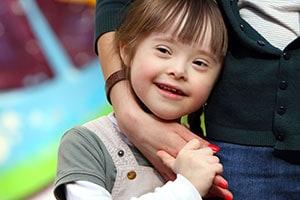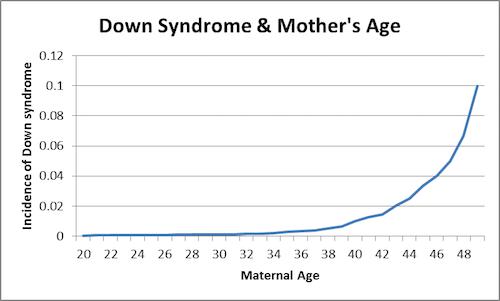Help Center
Online Resource Center for Information on Birth Injuries.
Down syndrome is a genetic disorder caused by abnormal cell division. The result is an extra copy of chromosome 21. This extra copy of genetic material is the cause of the physical characteristics of a person with Down syndrome and the reason why there may be some developmental differences in a patient who has this extra chromosome.
Patients with an entire extra copy of chromosome 21 have Down syndrome. The most common identification of people with Down syndrome is their face typically looks a bit different. Their eyes often have more slanted folds of skin at the inner corners. They typically have a smaller and flatter head, flatter ears, a large, thick tongue, and a shorter neck. People with Down syndrome also tend to be shorter. Other physical symptoms include poor muscle tone, and hyper flexibility; short, broad hands with a single crease across the hands, broad feet with short toes and a small oral cavity or enlarged tongue.
A random type of error causes down syndrome in the process of cell division, leaving a duplicate copy of chromosome 21. This particular type of cell division error is called nondisjunction. Typically, when a cell divides, the chromosome pairs split off, and each new cell gets one each. When nondisjunction occurs, however, the cell divides, but some chromosomes do not split off. One new cell ends up with duplicate chromosomes, and the other has none at all. Nondisjunction occurs during the formation of an egg or sperm and appears to be a random occurrence. Research has not been able to link any environmental or other factors to an increased risk of nondisjunction. We get deeper in the weeds of how Down syndrome may be caused later in this article.

Like cystic fibrosis, Down’s Syndrome is autosomal recessive. This means that the condition is genetic and passed down by the mother and/or the father but the condition is not shown in the parents. An autosomal recessive disorder requires two copies of the abnormal gene for the disease or trait to develop.
But Down Syndrome itself is neither dominant nor recessive. Trisomy 21 is an extra copy of chromosome 21. The idea of dominant versus recessive is not the correct lens to understand this condition because we are not talking about genes being passed down.
There are three major types of Down syndrome. Trisomy 21 is a chromosomal condition that occurs when there are three copies of a particular chromosome instead of the normal two copies. Trisomy 21 is caused by the presence that extra chromosome. This happens as a result of an anomaly in cell division during the development of either the egg or sperm during conception. It is the most severe form of Down. But there are many success stories, Trisomy 21 children who go on to live healthy, happy, and productive lives. Trisomy 21 makes up an estimated 95% of those who have Down syndrome cases. Not that it matters, but 88% of these cases stem from nondisjunction of the mother’s egg cell. (We are half tempted to leave that out. It is so unimportant. Attaching relevance to that fact is idiotic.)
The second type of is called translocation which accounts for 4% of Down syndrome cases. This is the result of the extra chromosome 21 breaking off and becoming attached or translocated to another chromosome. The presence of this extra piece of chromosome 21 cause some Down syndrome characteristics. As you might expect, the signs and symptoms in a patient with translocation are much less severe and may not be identifiable with the naked eye. Patients with translocation may have an increased risk of a child with Down syndrome.
The third type of Down syndrome is called mosaicism, where the extra chromosome 21 is present in some, but not all cells. Mosaicism accounts for only one percent of all Down syndrome cases. This rare type of Down is also the least severe. Research indicates that individuals with mosaic Down syndrome may have fewer characteristics of Down syndrome than those with other types of Down syndrome.
There is a test for Down syndrome. The most common test is amniotic fluid sampling by amniocentesis or obtaining tissue by chorionic villus sampling (“CVS”). But CVS is invasive and carries risks to the mother and what might be a very healthy fetus. CVS can cause a miscarriage. It may also cause fetal limb defects. The new MaterniT21 blood test is non-evasive and can catch 98% of fetuses that have Down syndrome. The test can cost a few hundred dollars even for patients who do have health insurance (the price has come down).
It is true that people with Down syndrome often have physical and intellectual development that is less advanced than their peers. But the good news is that many people with most people with Down syndrome are happy, productive people who have relatively medically uneventful lives. It is not correct to say Down patients suffer no more illness than their peers with normal chromosomes.
But, for many, the problems are navigable. Technology and research for Down syndrome have yielded great results. Even those with birth defects often have normal life spans. This is because advances in pediatric and cardiothoracic surgery have allowed surgical solutions to gastrointestinal and cardiac anomalies. For a minority of Down syndrome patients, there is a malady of potential complications.
The life expectancy of individuals with Down syndrome has increased significantly over the past few decades, primarily due to improvements in medical care and social support. Good things are happening here.
According to the National Down Syndrome Society, the average life expectancy for people with Down syndrome in the United States is now around 60 years, with many individuals living into their 60s, 70s, and beyond. There is no reason to believe these numbers will not continue to rise.
There is definitely an economic component to life expectancy with Down syndrome just like it is for everyone else. Limited access to healthcare and resources for many pulls life expectancy down.
Parents are eager to blame themselves when their child has Down syndrome. But there is no evidence that their environmental factors or something the parents did before or after childbirth that cause this condition. Which parent gave the child the extra chromosome? It could be either the mother or the father (and it does not matter). But it is not a genetic thing that is inherited like dominant and recessive genes. It is just a random thing that happens during cell division early in the pregnancy.
The random error in cell division is during the formation of the reproductive cells (egg and sperm) or early development of the embryo. However, there is a type of Down syndrome called “translocation Down syndrome” that can be inherited from a parent who carries a balanced translocation, which means that a part of one chromosome is attached to another chromosome. In this case, there is an increased risk of passing on the translocated chromosome to offspring, which can result in Down syndrome.
How does this random error in cell division happen? The prevailing theory was that people with Down syndrome produce an excess of proteins encoded by genes on chromosome 21, which disturbs the neurodevelopmental process by changing its timing, pattern, or extent. This concept is known as the “gene dosage effect.”
But recent studies using advanced RNA sequencing methods to examine cells from twin pairs – one with Down syndrome and the other without – have suggest this theory’s explanation is incomplete. Not only were the genes on chromosome 21 significantly upregulated in people with Down syndrome, but gene expression across all chromosomes was also disrupted, suggesting the presence of an additional factor.
Previous studies have shown that DS induces genome-wide transcriptional disruption, but the molecular mechanisms contributing to this effect were not known. This study utilized human-derived tissue samples and DS mouse models to investigate the underlying molecular mechanisms. The study found that T21, the genetic abnormality associated with DS, has a distinct genome-wide impact on the transcriptome, epigenome, and 3D-genome of neural progenitor cells (NPCs) that is absent in induced pluripotent stem cells (iPSCs).
In 2022, researchers at the Massachusetts Institute of Technology reported that senescent cells – the same cells linked to various aging-related diseases – may be the unexpected cause of Down syndrome.
This is important beyond our “why?” curiosity. Recent studies have shown the potential of targeting senescent cells for therapeutic purposes with senolytic drugs. These drugs selectively target and eliminate senescent cells. So this study could provide answers not only to questions about why someone may have Down syndrome, it might provide an exciting therapeutic avenue for treating Down syndrome by restoring dysfunctions induced by T21.
There are some of the less encouraging facts about Down syndrome:
The risk of cell division errors like nondisjunction increases as eggs get older, so as women age their chances of having a baby with Down syndrome increase. Statistics show that the chances of having a baby spike dramatically when the mother is 35 years or older.
The National Down Syndrome Congress, founded in 1974, is the national advocacy organization of families of children with Down syndrome, and of professionals and interested other persons who provide services to or otherwise assist persons with Down syndrome. Through over 500 local parent support groups, the NDSC carries on a broad range of activities. They fight to protect and secure the rights of persons with Down syndrome, the provision of information and other assistance to families of persons with Down syndrome to help them meet the special needs of these individuals, and the promotion of public understanding of persons with Down syndrome.
